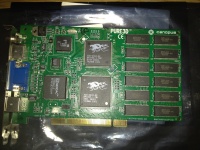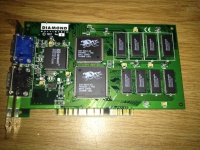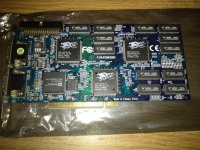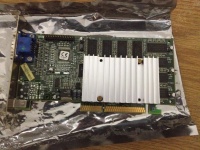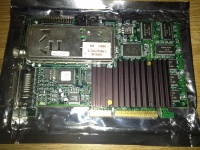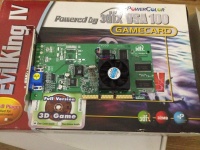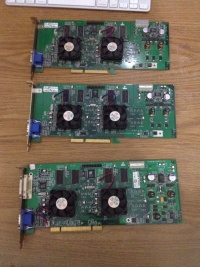3dfx
3dfx (written as 3Dfx until 1999) was a 3D graphics chipset manufacturer and later on graphics card manufacturer. Founded in 1994, the company was one of the pioneers of 3D graphics in the PC industry in the mid to late 1990's. They played an important role in the business until 2000, when most of their assets were purchased by Nvidia Corporation, after which the company filed for bancruptcy and officialy went defunct in 2002.
Contents
[hide]Voodoo Graphics
The Voodoo Graphics (retroactively named Voodoo 1) chipset was 3dfx' first foray into the PC market. Its release in 1996 was primarily made possible by EDO DRAM declining in price. The cards, which were manufactured by board partners, feature a frame buffer processor, a texture processor, a DAC and 4 MB EDO DRAM (some later versions were released with 6 or even 8 MB). Both the RAM and graphics processors operate at 50 MHz, with 2 MB RAM being used as framebuffer and 2 as texture memory. The chipset was rich in features, boasting perspective correct texture mapping, bilinear texture filtering, level of detail MIP mapping, sub-pixel correction, polygonal-based Gouraud shading and texture modulation. It natively supported Direct3D 5 and introduced Glide, 3dfx's own proprietary API that worked initially under DOS and later under Windows 9x and NT 4.0/2000/XP. Glide was essentially a cut down OpenGL implementation, with no support for features such as 32-bit color depth. OpenGL games were initially only supported through the use MiniGL, which were incomplete OpenGL implementations tailored for the particular target card and game. In 1999, 3dfx released a full OpenGL ICD, thus finally granting native support for OpenGL games, which was becoming more and more important since full OpenGL support was required for the then-upcoming Quake 3.
The main disadvantage of the cards was that they could only do 3D, meaning that they had to be used in conjunction with a standard 2D card through means of a passthrough cable. During boot and regular PC operation the 2D card would display the image like usual and run the signal through the Voodoo; however, when a compatible game was ran, the Voodoo Graphics would be enabled, taking over the host card. Combinations with S3 Graphics cards, as well as Matrox cards were quite popular. Unfortunately, the passthrough method was very dependent on the build quality of the used cable and could potentially lead to blurriness.
Thanks to 3dfx's efforts with videogame developers and publishers - the company's technology was quickly adpoted as the de-facto standard in PC 3D gaming - the Voodoo 1 enjoyed a lengthy support from game developers. Despite only supporting resolutions as high as 640x480 (800x600 without the usage of Z-buffering) and 16-bit depth, the card was more or less usable until 1999, when its performance in new games would have been slow.
The prime competitors upon its release were the PowerVR PCX1 and Rendition Vérité V1000 chipsets, the later of which already featured 2D processing onboard. Other competitors include the Matrox Millenium II/Mystique, ATI Rage II, S3 Virge and Nvidia RIVA 128, all of which had 2D functions, but only the RIVA 128 can be said to match the Voodoo 1 in performance, while of course lacking Glide support.
Today: The card's prime usage would be statically linked Glide games in DOS that depend on the first Voodoo chipset. Later games, starting with ca. 1997, are better played with the subsequent Voodoo cards.
Voodoo Rush
The first 2d and 3d in one graphics card by 3dfx.
Voodoo 2
Released in early 1998, the Voodoo 2 chipset expanded upon its predecessor by adding a second texture processor and featuring 12 or 8 MB EDO DRAM. The clock was increased to 90 MHz, therefore almost doubling the performance. Since the V2 features single-pass multitexturing and single-pass trilinear filtering (and therefore supports Direct3D 6), performance in games utilizing these features is even more increased, with the first notable one being Quake II (1997). Additionally, the cards support SLI (Scan-Line Interleave), a technique which allows 2 cards to be run simultaneously and draw the lines of the image in turn, further increasing performance and enabling resolutions up to 1024x768. With one card installed, up to 800x600 is possible.
A large amount of cards from different manufacturers was released, with some deviating from the reference design and/or featuring extra cooling and even slight factory overclocks. The Voodoo 2 remained the best 3D accelerator card throughout 1998.
Today: The iconic Voodoo 2 SLI setup holds nostalgic value for some people that experienced it back in the day. Thanks to the PCI interface, they can theoretically be used even in some modern mainboards, although there are rumors of them overheating in modern systems. In any case, the setup remains viable for the vast majority of Glide games released and can even play some Glide games originally only designed for Voodoo 1 through a special batch file, although for later games, the newer cards have to be considered superior.
Banshee
Voodoo 3
The Voodoo 3, codenamed Avenger, was announced on COMDEX in November 1998 and released on April 3, 1999. Following the buyout of STB, 3dfx was now manufacturing their own cards. The Voodoo 3 was basically a higher clocked Banshee core outfitted with a second texture unit, therefore also incorporating the 128-bit 2D unit. The cards were released in four different flavors: the 125MHz Voodoo 3 1000, the 143MHz Voodoo 3 2000, the 166MHz Voodoo 3 3000, and the 183MHz Voodoo 3 3500 TV with integrated TV tuner. Aside from the lowest-end part which could come with either 8 or 16 MB of memory, all cards featured 16 MB of SDRAM, with some PCI cards instead having SGRAM. The maximum resolution is 2048x1536.
Now facing stronger competition from Nvidia's RIVA TNT line, which already had 32-bit color depth, higher than 256x256 texture support and AGP texturing support (all 3dfx cards use the AGP port as a mere 66MHz PCI port), the Voodoo 3 line was somewhat panned by critics and called outdated in terms of features, but was still considered to be very competitive speed-wise. At that time, 3dfx' marketing was centered around speed, but to demonstrate that the image quality was still better than their last year's setup, they invented the term "22-bit", describing the fact that the RAMDAC of the card would perform either a 2x2 box or 4x1 line filter on the image, depending on the driver settings, masking some of the dithering.
Today: Since 32-bit rendering on competitor cards introduces a big hit on peformance, the Voodoo 3 can be considered the overall best card. The GeForce 256, which came out later that year, beats it by features and performance in D3D and OGL games, but can merely tie it in some Glide-centric games such as Unreal Tournament. Furthermore, the 16-bit rendering of the card is of a higher quality than others and it features good DOS compatibility and speed. Like with all Voodoo cards, the card will run games requiring 8-bit paletted textures or table fog. If all this is taken into account together with the card's wide availability and low cost, the Voodoo 3 can be considered the all-around best "retro" card for games of its time frame and before.
